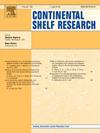Exploring concentration of chlorophyll-a, SST and salinity variability over the Bay of Bengal: Integrating ROMS model and in-Situ observations
IF 2.2
3区 地球科学
Q2 OCEANOGRAPHY
引用次数: 0
Abstract
This study is to replicate the oceanic circulation pattern in the Bay of Bengal (BoB) spanning from 1998 to 2014 using Regional Ocean Modelling Systems (ROMS). The model's performance in seizing the ocean's most vital features, such as sea-surface temperature (SST), salinity, chlorophyll-a (Chl-a) concentration, and surface currents, has been analyzed. The model represents spatial dynamics, with seasonal change progressing from the northeast to the southwest within the Bay of Bengal. From MAM, the southern BoB and central region of BoB areas demonstrate warming trends, whereas the SST increase in the northern BoB is a result of JJAS. These shifts are a result of changes in sun irradiation, mixed layer depth variations, and freshwater influx. The model shows relative alignment with the observed data, except during JJAS, where higher SSTs were observed. These higher SSTs are likely due to the intricate interactions involving monsoon-driven atmospheric variability, which impacts surface heating and freshwater influx, as well as unresolved model parameters related to vertical mixing and heat flux processes. The research work to be done requires quantification of the model's performance, and the statistical methods yield a moderate correlation for both SST and concentration of Chl-a. A variety of factors, including upwelling, coastal dynamics, and atmospheric processes, can explain these patterns. The paper emphasises the idea of the complex character of coastal processes, and it emphasises the importance of adequate representation of these phenomena in the models. The modelling of concentrations of Chl-a also exhibits a distinct seasonal trend, and the model duplicates essential features but shows biases near the coastal areas, likely due to limitations in the model's horizontal resolution, the treatment of freshwater input, and the representation of coastal upwelling processes. Positive and negative anomalies of the SST and the concentration of Chl-a are connected with the complex interaction of ocean-atmosphere systems, thereby demonstrating the interplay of different factors. Fundamentally, the research points to the significance of faithful simulation of ocean circulation and coupled elements for the proper assessment of the highly complicated BoB dynamics.
探索孟加拉湾的叶绿素-a浓度、海温和盐度变化:整合ROMS模式和原位观测
本研究利用区域海洋模拟系统(ROMS)复制了1998 - 2014年孟加拉湾(BoB)的海洋环流模式。分析了该模式在捕捉海洋最重要特征方面的性能,如海面温度(SST)、盐度、叶绿素-a (Chl-a)浓度和海面洋流。该模式反映了孟加拉湾内部从东北到西南的季节变化的空间动态。从MAM上看,南BoB区和BoB区中部地区呈现增温趋势,而北BoB区海温增加是JJAS的结果。这些变化是太阳照射、混合层深度变化和淡水流入变化的结果。模型显示出与观测数据的相对一致性,除了在JJAS期间观测到较高的sst。这些较高的海温可能是由于涉及季风驱动的大气变率的复杂相互作用,它影响地表加热和淡水流入,以及与垂直混合和热通量过程有关的未解决的模式参数。要做的研究工作需要对模型的性能进行量化,统计方法对海表温度和Chl-a浓度都有适度的相关性。包括上升流、海岸动力和大气过程在内的各种因素都可以解释这些模式。本文强调了海岸过程的复杂特征,并强调了在模型中充分代表这些现象的重要性。对Chl-a浓度的模拟也显示出明显的季节性趋势,模型复制了基本特征,但在沿海地区附近显示出偏差,这可能是由于模型的水平分辨率、淡水输入的处理以及沿海上升流过程的表现方面的限制。海温和Chl-a浓度的正、负异常与海洋-大气系统的复杂相互作用有关,从而体现了不同因素的相互作用。从根本上说,该研究指出了忠实模拟海洋环流及其耦合要素对于正确评估高度复杂的BoB动力学的意义。
本文章由计算机程序翻译,如有差异,请以英文原文为准。
求助全文
约1分钟内获得全文
求助全文
来源期刊

Continental Shelf Research
地学-海洋学
CiteScore
4.30
自引率
4.30%
发文量
136
审稿时长
6.1 months
期刊介绍:
Continental Shelf Research publishes articles dealing with the biological, chemical, geological and physical oceanography of the shallow marine environment, from coastal and estuarine waters out to the shelf break. The continental shelf is a critical environment within the land-ocean continuum, and many processes, functions and problems in the continental shelf are driven by terrestrial inputs transported through the rivers and estuaries to the coastal and continental shelf areas. Manuscripts that deal with these topics must make a clear link to the continental shelf. Examples of research areas include:
Physical sedimentology and geomorphology
Geochemistry of the coastal ocean (inorganic and organic)
Marine environment and anthropogenic effects
Interaction of physical dynamics with natural and manmade shoreline features
Benthic, phytoplankton and zooplankton ecology
Coastal water and sediment quality, and ecosystem health
Benthic-pelagic coupling (physical and biogeochemical)
Interactions between physical dynamics (waves, currents, mixing, etc.) and biogeochemical cycles
Estuarine, coastal and shelf sea modelling and process studies.
 求助内容:
求助内容: 应助结果提醒方式:
应助结果提醒方式:


